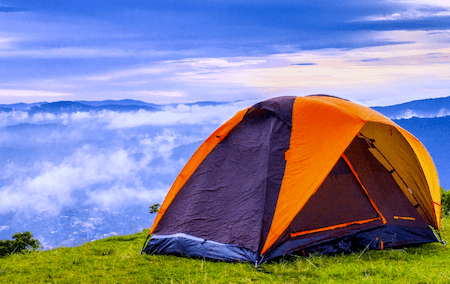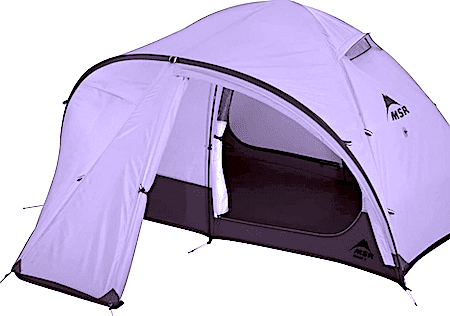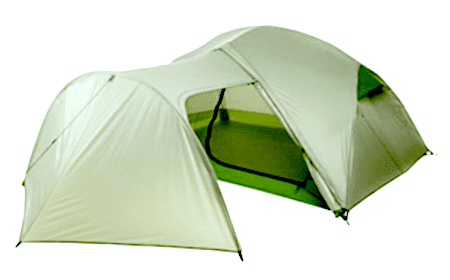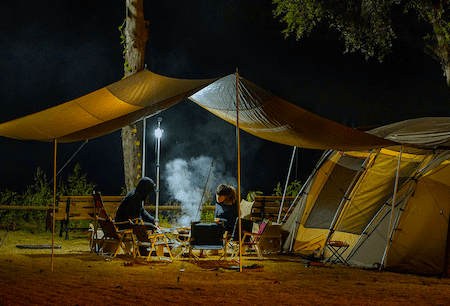Having been camping, have you ever woken up to everything you left outside your tent last night soaked up in the rain because you didn’t have the space to store them?
Or how about messing up the cozy tent interior with muddy boots because you couldn’t take them off elsewhere? If you have, then this is what a tent vestibule is for.
Vestibules are basically extensions of your tent that add more room to your tent. They act as an “entrance” area where you can store all the gear while you’re still in the tent and easily get it at night without disturbing anyone else.
Read ahead to find out what is a tent vestibule, why you might need one, and the related concerns that tag along.
What Is A Tent Vestibule?
Tent vestibules are basically awnings for tents. They extend from your tent’s front so that you have protection from the elements as you enter.
Likewise, tent vestibules may extend along the sides and ground of the tent, and can typically be closed, effectively expanding the tent’s size with a second entrance.
Tent vestibules also provide additional space to store your camping gear, a handy feature when you’re running out of room.
When your tent has a vestibule, you needn’t worry about mud tracking into your sleeping area since you can take your shoes off and clean your feet under the vestibule’s enclosure before stepping in.
What Do Tent Vestibules Do?
The vestibule of your tent will serve to shield you from the elements as you enter it.
Meaning it’s pretty much a transition space within your tent where you can dry yourself off when soaked up in the rain before going into your tent’s main chamber, thus keeping water and mud out.
Additionally, you can store your stuff in the extra space that comes along. However, sleeping in your tent vestibule won’t be a good idea, as it will be less protected from rain than the interior part.
Types Of Tent Vestibules
Although there are many types, styles, and sizes of vestibules, you can have an overview of the most common types from the following.
Front Vestibule
A front vestibule attaches to the tent’s entrance, and it sometimes comes built-in to the tent. You can, however, purchase one separately if you so desire.
Front vestibules serve as a sort of porch, making them an excellent solution if you anticipate bad weather. Generally, front vestibules are pretty large, so they would be ideal for packing some gear into smaller tents or storing bulky items.
Another wonderful thing about front vestibules is that they can double as handy, tiny camping kitchens.
They are your ideal cooking space in harsh conditions in the wilderness so long as you don’t accumulate carbon monoxide buildups or set it ablaze negligently.
Side Vestibules
A side vestibule is the preferred option for group campers, not only because of its extra space but also because it keeps the entrance clear.
It typically has two entryways, one for entering the tent and another for storing stuff. The ‘side,’ here, relates to the tent’s longest side.
Side vestibules are better suited to camping in good weather conditions. With their porch-like appearance, they offer a fantastic view of nature as the rain belts down on your tent.
With a wide entrance that branches out on the other side, they also keep your gear safe from exposure.
Besides, they may provide additional storage space for the one-person tent, and two small backpackers may fit inside them comfortably.
However, these vestibules are rare to find on tents as add-ons, and neither can you buy them separately.
Zip-On Vestibules
Zipper Awnings are unique vestibules that offer not only storage space but also a porch or awning to enjoy your surroundings and it sometimes comes built-in with the 12 person tent.
A more extended awning than other vestibules makes them much more spacious than the previous two types.
This design has the advantage of having an awning with a zipper, which you can zip back into the tent, essentially creating a wide vestibule to keep things.
Although a bit expensive, this tent offers the best views of the surrounding area.
Why Would You Need A Tent Vestibule?
The following benefits explain why you might need a tent vestibule.
#1. Helps Maintain A Clean Tent
As of yet, we have emphasized this point a great deal.
In case you still aren’t convinced, picture this- you’ve trekked through the wilderness, spent the whole day outdoors, and dirtied your clothes and boots terribly in the process.
You surely won’t want your tent to receive the same treatment afterward.
That’s when you’ll want extra space to take off your dirty clothes and boots for changing into cleaner ones, and a tent vestibule gives you just that.
It won’t have any floor either, so you won’t need to bother cleaning it. And if you feel you want a floor-like surface anyways, only a tarp or a tent footprint should suffice.
#2. Adds Additional Gear Storage
The additional storage space is one of the main reasons people turn to tent vestibules. It is a fact that most tents are often too small to accommodate all your gear, and they lack sufficient storage space.
But when you have a tent vestibule, you will no longer feel the lack of space in your tent.
Besides, a vestibule can protect your gear from getting wet during rain or even a storm if it’s well-built. Several zip-on vestibules (like this one) also let you keep everything protected with zippered doors.
#3. Acts As Weather Guard And View Spot
Being caught in the rain is never fun and staying inside your tent isn’t always fun either. So, if you would like to keep track of the shower and enjoy the drizzle, a tent vestibule could be a helpful accessory.
If you wish, you may sit under the shade in a pair of good camping chairs and chat with a mate without wetting yourselves.
Once again, if you wish to prevent rain from getting in from below, you might want to use a tent footprint.
Fortunately, most footprints and vestibules are easy to clean when taken apart.
#4. Serves As A Space For Winter Cooking
Another practical advantage of a vestibule tent is that it allows you to cook indoors in the winter. It’s pretty challenging to start a campfire below zero degrees.
Hence, if you don’t want to venture out in the elements, you can cook in the vestibule of your tent.
However, there are some potential safety concerns here, as you can imagine. Carbon monoxide poisoning and having your tent burnt down are just some of the risks involved.
So, if you plan on cooking in the vestibule, you must follow some essential safety precautions. For instance, you should use a canister stove with flame control.
#5. Makes Your Tent Look Bigger
This last point may not sound much like a benefit to most. Still, while aesthetics might not be crucial for all campers, many are concerned about them.
And adding a vestibule to your tent can add to its size without having to buy a larger tent. In other words, it will be a great way to keep everything in order and create a bit of extra space.
Downsides Of Having A Tent Vestibule
Tents with vestibules don’t have that many downsides. One downside is that they typically come with more feature-rich tents, making them more expensive than tents without vestibules.
Additionally, a tent with a vestibule is no longer free-standing. In other words, even if the inner tent is free-standing, you will need to stake the vestibule flaps to create a functional entrance and storage space when the fly is on. It’s a trade-off of some sort.
Although many tent manufacturers refer to tents with vestibules as freestanding, they are not always the case because of this reason.
When to Consider Getting a Tent Vestibule?
Vestibules seem to be a must-have initially, as they provide campers with a covered area.
However, they are not a necessity for every camping trip. For instance, you may not need it if you’re camping in some warm or calm weather or if you’re carrying light equipment.
On the other hand, tents may benefit immensely from having a vestibule in some situations. For example, if you’re camping in cold and/or wet weather, a vestibule is indispensable for storing things, changing clothes, and cooking.
The X-factor may come into play as well. Some people might desire tents with vestibules, while others prefer a unit with as many amenities as possible.
And let’s not forget the weight of vestibules. If you’re hauling a tent vestibule all day, you’d better be prepared. As nearly all hikers know, carrying extra weight can quickly add up, and it can soon feel like toting around a ton of bricks.
Specifically, you should consider where and how long you intend to camp. If you’re camping in some 4-season region that rains or snows frequently, you should consider purchasing a vestibule.
Another reason you may want this tent feature is when you are camping with your family for several days.
How Do You Tell If A Vestibule Is Iffy?
Unless you’re camping in some 3-season region that may be prone to rain or chilly weather, you can go without it.
Plus, a vestibule isn’t necessary if you stay in a place for 1-2 days. Finally, you do not really need it if you have only a few items to carry.
As a rule of thumb, you’ll want to thoroughly analyze your camping demands. That will determine if a tent with vestibules would make sense for you and which kind would be best.
How Big A Vestibule Do You Need?
Depending on how you plan to use it and what you need to store there, you’ll need a certain amount of vestibule space.
For example, you wouldn’t want a massive vestibule if you were only looking for a small entrance to take your shoes off. However, if you’re going to store something big- a bike, for instance, you’ll obviously need a more spacious one.
In the winter, you may also want a vestibule that stretches further beyond your tent’s space if you plan on cooking inside it.
Generally, the vestibule space per person should be about six square feet. However, this might be too much for tents that accommodate more than six people.
Final Thoughts
So, that’s that. If you were unsure what is a tent vestibule, what it does, and why it is essential, we hope this article clarified that for you.
As with the tent footprint, the tent vestibule is something you should learn about and consider adding to your gear. While it may not always be necessary, it will undoubtedly benefit you in some ways if used.
Lastly, be sure to choose the proper vestibule for your camping needs, and look for quality materials that will withstand weather conditions and wear and tear.






